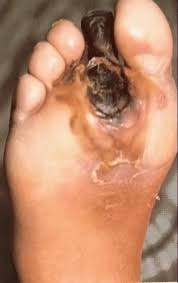More Nigerians develop diabetes mellitus foot
Caption:
A Diabetes Mellitus foot
Pa Emmanuel Dodoh never really paid any serious attention to his blood sugar level, least of all his feet, when he was diagnosed with diabetes 28 years ago. He walked around on bare foot to the market and never bothered to change his sandals even when they had holes on them.
However, last year, luck ran out on him as he sustained an injury on his left foot that refused to heal.
“I was hit by a stone while working, some days later, I found out that the sore had refused to heal. So my family took me to the Christian group medical centre, Warri where the wound was dressed and my feet bandaged,” he narrated to National Mirror.
This treatment however worsened his condition as the foot got infected from the dressing. By the time he got to the General Hospital, Warri, he was told by the doctor that the infection was already spreading so fast and could result in death if the leg was not amputated immediately.
Pa Emmanuel had his left lower limb amputated in August 2013 and was only too glad to be alive. He told National Mirror that he has been living a normal life with his new prosthesis limb.
Pa Emmanuel is not alone. Studies from international diabetes federation estimates that about a quarter of people in Nigeria with newly diagnosed diabetes already suffer foot ulceration. The studies further revealed that in 2005, people with diabetes-related foot ulceration were almost 12 percent of total hospital admissions.
Dr. Afoke Isiavwe an endocrinologist told National Mirror that most patient with diabetes mellitus foot disease end up dead. According to Nigeria African journal of Endocrinology and metabolism, Diabetes mellitus foot is the second leading cause of diabetes-related deaths in Nigeria, accounting for 19.5 to 24 percent of all diabetes mortality.
Further studies in International Diabetes Federation, says that 85 percent of diabetes related lower extremity amputations are preceded by a foot ulcer. A recent publication of a Profile of amputations in Lagos University Teaching Hospital, Lagos, Nigeria in Nigeria Medical journal 2013, showed diabetes-related foot ulceration accounting for most amputation in the surgical unit (55.14 percent of all amputation).
However, Dr. Isiavwe says 85 percent of these ulcers and amputations could be prevented by early recognition and management of risk factors.
For instance, the risk of ulcers or amputations is increased in people who have had diabetes for more than 10 years, are male, have poor glucose control, or have cardiovascular, retinal, or renal complications, she said.
Other warning signs according to her include Peripheral neuropathy (loss of sensation in the foot), swelling of the foot or ankle, very cold feet or legs, colour change: red, blue or black discoloration, pain in the legs while at rest or while walking, open sores, none healing wounds, in-growing toe nails, corns and callouses.
She stressed the need for all individuals with diabetes to receive an annual foot examination to identify high-risk foot conditions.
“The presence of Erythema (reddishness of the skin), lump or callus formation may indicate areas of tissue damage with impending breakdown. Bony deformities, limitation in joint mobility, and problems with gait and balance should be assessed,” she said.
According to her, People with loss of sensation may be adequately managed with well-fitted walking shoes or athletic shoes. They should also be educated on the implications of sensory loss and the ways to detect signs of problem.
She advised such persons to always wear footwear that cushions and redistributes the pressure also adding that calluses can be removed with a scalpel by a foot care specialist or other health professional.
Also, she further advised, People with bony deformities (e.g., hammertoes, prominent metatarsal heads, and bunions) may need extra-wide shoes or depth shoes while those that cannot be accommodated with commercial therapeutic footwear may need custom-moulded shoes.
She warned that Minor skin conditions such as dryness and tinea pedis (fungi foot infection) should be treated to prevent the development of more serious conditions. .
Experts have declared that people with diabetes have an increased risk of developing foot ulcers. Studies from International diabetes Federation (IDF) shows that diabetics often develop foot problem such as nerve damage, also called neuropathy, which result in loss of feeling in your feet, or peripheral arterial disease (PAD) which reduces blood flow to the feet.
Diabetes nerve damage makes an individual not to feel much pain when pricked by sharp objects so he can easily get injured without feeling or knowing it. Such an individuals may have a tack or stone in his shoe and walk on it all day without knowing or feeling the blister, even tight shoes can easily injure you because of reduced feeling.
About author
You might also like
12 benefit from SEOF-sponsored open heart surgeries in Anambra
No fewer than 12 patients have benefited from Sir Emeka Okwuosa Foundation (SEOF)-sponsored Open Heart Surgeries, conducted from May 14 to 26th May 2023, at Dame Irene Okwuosa Memorial Hospital,
Public Advisory on Cerebrospinal Meningitis Outbreak in Nigeria
Nigeria is currently experiencing an outbreak of Cerebrospinal Meningitis (CSM) that has spread across the country and mostly affecting States in the upper parts of the country which fall within
Governments resolve to reduce suffering, deaths from noncommunicable diseases
MONTEVIDEO, Uruguay – Heads of State , Government and ministers from around the world have committed to new and bold action to reduce suffering and death from noncommunicable diseases (NCDs),









0 Comments
No Comments Yet!
You can be first to comment this post!